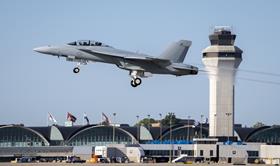US fighter manufacturer Boeing has delivered the first aircraft under a programme to upgrade the US Navy’s (USN’s) existing F/A-18 Super Hornet jets to the latest Block III standard.
Boeing, which manufacturers the F/A-18 in St. Louis, Missouri, said on 27 June it had delivered two upgraded Super Hornets to the navy under a service life modification (SLM) programme.

That upgrade provides 4,000-flight-hour increases to each jet’s service life, and involves equipping the fighters with improved avionics and modernised cockpits with large-area touch-screen displays. Boeing began work under the SLM programme in July 2023. Under an agreement with the navy, Boeing plans to open another Block III SLM line in San Antonio, Texas.
The airframer is separately assembling new-build Block III Super Hornets under a $1.3 billion contract awarded in March that is expected to be the USA’s final F/A-18 order.
Boeing says the Super Hornet production line is currently scheduled to cease operating in 2027.
During a 26 June tour of Boeing’s fighter production campus in St. Louis, vice-president of air dominance Steve Nordlund told FlightGlobal the F/A-18 programme has hit a “point of no return” where a shutdown is likely unavoidable.
Past a certain time, the necessity of procuring long-lead items necessary for aircraft production creates difficulties in extending Super Hornet production, even if an unexpected new order emerged from the US or elsewhere.
“You’ve got to keep a supply base engaged,” Nordlund says, noting that many small “mom and pop” companies supply the F/A-18 programme and have limited ability to adjust production.
The USN operates more than 600 F/A-18 fighters across its operational and training fleets, according to Cirium data. The service also flies more than 150 of the EA-18G Growler electronic-attack derivative of the Super Hornet.
Even after production of the venerable type ends, the Super Hornet is expected to remain the navy’s primary carrier-based fighter for decades, flying alongside less-numerous Lockheed Martin F-35Cs.


























